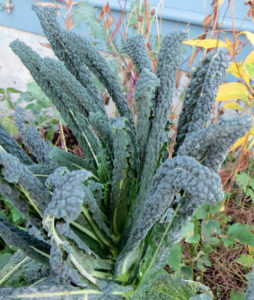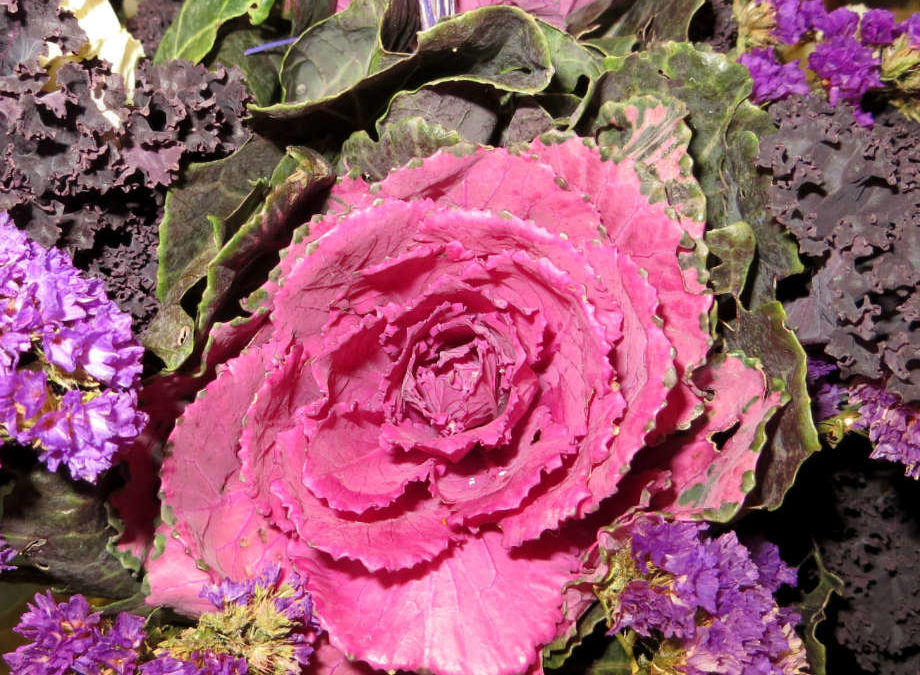What is on your Thanksgiving table? Where did your food come from? For a dozen people my table is laden with parsley from my yard, oodles of vegetables and fruit from the farmer’s market, a pre-cooked naturally raised turkey from my neighborhood grocery store, and specialty treats and additions from miles and seas away. To provide a Thanksgiving repast of my foremothers it takes something from everywhere to complete the meal.
I support local agriculture, because it is easy to do, sustains local farmers, protects the rural economy, maintains the country landscape that is critical to the Northwest quality of life, and most importantly the food is fresher. Adding delectable food products into my Thanksgiving meal from outside the northwest foodshed, inserts flavor and connects me with my heritage. My holiday spread will feature food from outside my door to across oceans.
My Yard
I live on a 5,000 square foot city lot on the backside of a hill that faces northeast. In the summer, sun is plentiful and I strategically locate blueberries, a plum tree, tomatoes, beans, basil, and other summer producing plants in raised beds to grow food.

Dino Kale in my Yard
By November with minimal sunlight, parsley, rosemary, thyme, dino kale (Lacinto Kale) and chard continue to thrive growing alongside four different types of over-wintering garlic. Kale is the ubiquitous northwest biennial vegetable growing over a meter tall. It tops the charts in nutritional value providing beta carotene, vitamin K, vitamin C and calcium along with potentially blocking cancer growth, lowering cholesterol and of course, adding fiber. Kale can be a stand-alone vegetable, but works better for my family in soups and stir-fry recipies.
This holiday, garlic from my 2013 harvest, kale, and Italian parsley are all in my stuffing.
The Farmers Market
The pre-Thanksgiving University District Farmers Market was bustling in part, since there was no Seattle rain to be found. The farmers’ stalls were loaded with carrots, parsnips, Brussels sprouts, cabbage, and other brassicas sweetened by the autumn’s cool temperatures. Four separate trips to my car were necessary to carry my load of glass bottled cider, Yukon Gold potatoes, hazelnuts, sweet potatoes, onions, leeks, apples, pears, cranberries, and a posy of ornamental kale flowers. Other shoppers pushed folding metal carts filled to the brim, employing an auto trip stash reduction method, that I should consider.
The sweet potatoes and decorative kale bouquet were my unexpected purchases. More than 96% of the nation’s sweet potatoes are grown in North Carolina, California, Mississippi and Louisiana with the vast majority grown in the Atlantic coast state, so buying northwest grown tubers was notable. An abundance of sweet potatoes along with tree fruits are a specialty of Lyall Farms in the Yakima Valley with its hot summers and plentiful irrigation water. My Thanksgiving meal is complete by cooking my annual tradition, Mollie Katzen’s Sweet Potato Surprise with apples, bananas and ginger blended into orange sweet potato goodness.
The Asian immigrant farmers, creators of year-round floral beauty have fashioned an almost rose-like bouquet using the tops of decorative kale. Throughout the summer, larger kale leaves were removed to surround summer splendor. Now with only the cream and burgundy colored tops remaining, farmers design bouquets with statice and wheat stalks to grace my Thanksgiving table.
Grocery Store and the World
Having never learned to cook the Thanksgiving icon, my naturally grown pre-cooked turkey comes from the grocery store. It doesn’t meet the criteria for a locavore purist, but it saves me from family strife and an under-cooked bird. But, with each morsel of meat, I thank the animal that graces my table remembering its beauty and the nourishment it gives me.
All prepared foods include some product grown in another part of the world, as spices are a common import. Even the lowly peppercorn native to southern India, is grown throughout the tropics and is an essential ingredient. The world has a long history of food imports, whether spices from the Far East, citrus from warmer climates or exotic treats from faraway lands.
As a child, my grandmother would tell me the stories of her grandfather, E. Eugene (“Gene”) Hawkins, born in Long Island, New York as the oldest son of a ship’s carpenter. In 1894, at age 49, he became part owner of the 372,960 ton B.J. Hazard schooner, a work horse of the Atlantic. As the ship’s captain, he engaged in coastal trade predominately between New York and Havana, only knowing what his return cargo would be upon port arrival.
Other times Gene sailed to the warm Mediterranean climate. On leaving the Long Island port on one journey with his wife Georgianna, he said to a fellow East Patchogue captain, that he would kill a pig, if they met mid-ocean. A pig roast ensued in the Atlantic doldrums. On another winter voyage with a load of oranges, he waited six weeks for the tides and the winds to cooperate at the Straits of Gibraltar. Sadly, his cargo was rotten upon reaching homeport.
On Thanksgiving, cranberry-orange relish will adorn my turkey. Remembering that citrus was a extraordinary winter delicacy transported by my ancestors, oranges always show up in our Christmas stockings, too.
As the holiday season approaches, pay attention and include local foods in your celebrations, and be sure to take pleasure in the treats from far away.
Kathryn Gardow, P.E., is a local food advocate, land use expert and owner of Gardow Consulting, an organization dedicated to providing multidisciplinary solutions to building sustainable communities. Kathryn has expertise in project management, planning, and civil engineering, with an emphasis on creating communities that include food production. Kathryn is a Washington Sustainable Food and Farming Network board member. Kathryn’s blog muses on ways to create a more sustainable world.

